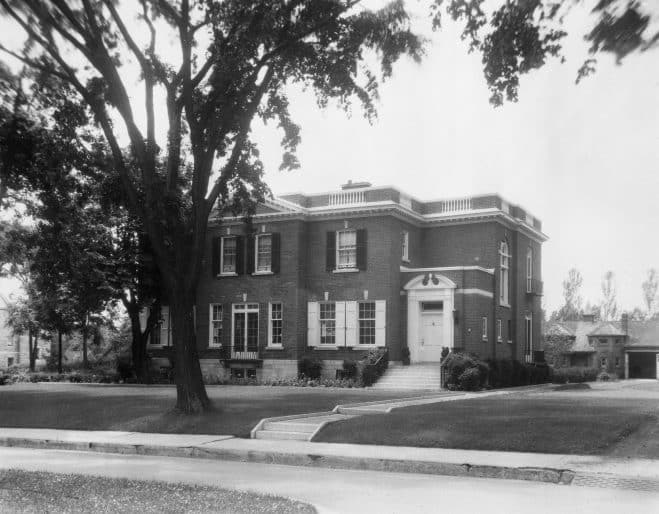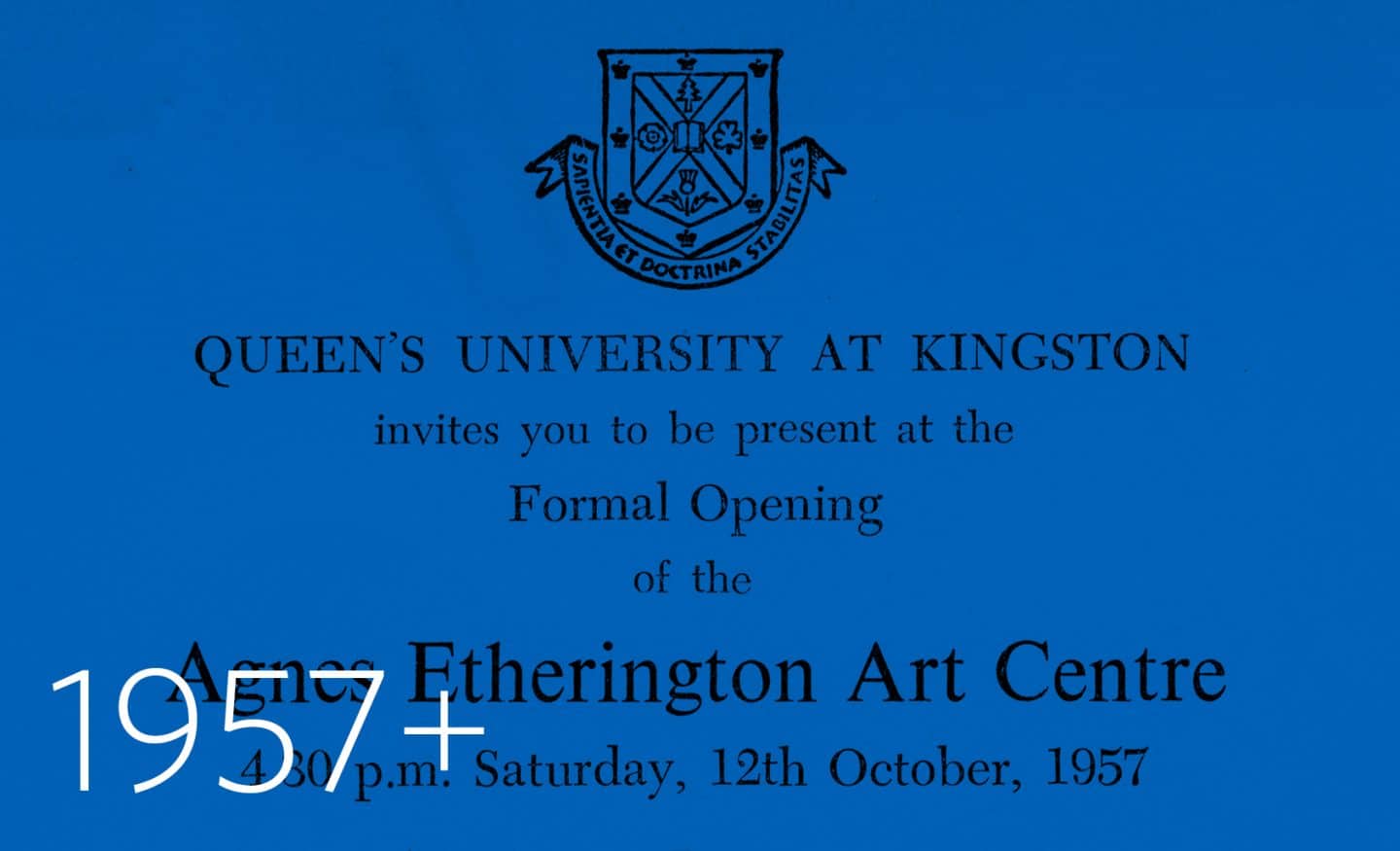


The Agnes Etherington Art Centre formally opens to the public on 12 October, in a building bequeathed by local philanthropist Agnes McCausland Etherington (née Richardson). Tea is served to 130 assembled guests, who view the exhibition Canadian Paintings on Loan from Kingston Collections. Artist and Queen’s professor André Biéler is inaugural director, having supervised renovations that turned Etherington’s lifetime home into a cultural institution for the university and Kingston community.
As a “Centre,” the Agnes houses exhibition and lecture spaces in the former dining room and kitchen, as well as an art library and studio spaces upstairs, shared by Queen’s Department of Art, the Summer School of Fine Arts and community art classes. Frances K. Smith is hired as Biéler’s assistant. Works of art given to the university in preceding years, through the Queen’s University Art Foundation and other donors, form the nucleus of the Agnes’s permanent collection.
The Agnes becomes the regular home for an annual juried Spring Exhibition, initially organized by the Kingston Art Association. Over the next seventeen years, the Spring Exhibition draws submissions from Kingston and beyond, which are juried by invited artists, art critics and curators. In 1960, art critic Pearl McCarthy chooses ninety-eight works from twice as many entries and writes about her jurying experience in The Globe and Mail. By the 1975 Spring Exhibition, which focuses exclusively on drawing, there are 591 entries by 199 artists from across Ontario.
Canadian artists are invited from across Canada to send works for the inauguration of picture loan services in Kingston. For a nominal fee, Kingstonians can borrow an original work of art for one month or more. Reproductions and prints also become available to Queen’s students for the academic year. The art rental program at the Agnes, which continues through 2014, is first run by a volunteer committee, and later by the Gallery Association.
The Agnes plays a vital role in the summer Emily Carr Festival. An exhibition of the artist’s paintings, on loan from Toronto collector Charles S. Band, coincides with Queen’s Department of Drama’s production of Emily Carr, A Stage Biography with Pictures, a new play by Herman Voaden. A public lecture on Carr’s work by her artist-friend Yvonne Housser and a screening of the National Film Board of Canada’s Klee Wyck also take place in nearby Ellis Hall. Twenty-three years later, in 1983, the Agnes acquires its first Carr paintings, by purchase and gift, through Montreal art dealer Max Stern.
The Agnes makes its first purchase of an Inuit print, Natsivaar’s Angels in the Moon (1960), from a display of the second Cape Dorset Annual Print Collection, courtesy of the Arts and Crafts Shop (Domus), Kingston. Concurrently, Paintings, Drawings and Prints by Tony Urquhart is the first solo exhibition of a Canadian artist at the gallery. Prior to its Kingston opening, the exhibition tours through the Queen’s Art Circuit, initiated by the Agnes to facilitate the circulation of exhibitions in Southern Ontario.
The Agnes undertakes its first expansion, funded by Queen’s University and the Canada Council for the Arts. With André Biéler’s input, the architectural firm Mackenzie, Marshall and Merrett designs a new exhibition gallery, sculpture terrace and studio space. The main entrance moves to the south side, off Queen’s Crescent (today Bader Lane). The Festival of Art and Music and an exhibition of British art, Constable to Bacon, mark the occasion. Queen’s Department of Art—including art history and studio classes—continues to be located at the Agnes until the late 1960s.
At the end of the year, Queen’s alumnus Samuel Zacks and his wife Ayala donate ninety works of art, primarily contemporary Canadian, the largest gift to the collection to date.
André Biéler’s retirement as founding director is marked by a retrospective exhibition with works from the Agnes collection, other public galleries and private collectors. Quoting the poet John Keats, Queen’s principal James Corry writes in the catalogue, “It is a fitting climax that these splendid new galleries in the Art Centre should ‘hold like rich garners the full ripen’d grain.’”
Subsequent directors of the Agnes are Ralph Allen (1963–1973), Michael Bell (1973–1978), Robert Swain (1978–1990), David McTavish (1991–2001), Janet M. Brooke (2002–2012) and Jan Allen (2014–present).
Early Canadian Dress is the first public display of Kingston family heirlooms from the Museum Collection of Dress (today the Queen’s University Collection of Canadian Dress), selected by its founder and curator Margaret Angus. Having originated as costume donations for Queen’s drama productions, the collection is placed under the care of the Agnes in the mid-1980s, and moves to the gallery’s premises in 2000 when new storage facilities are made possible through the generous support of Dr. Isabel Bader.
The Gallery Association (GA) is formed in September “to develop an expanded program of art activities in cooperation with the Art Centre and to provide valuable auxiliary services.” Active for almost fifty years, the GA is a vibrant organization with various committees, responsible for the art rental program, guide service, school groups, film program, bus tours, public lectures, special events, and other activities. Funds are raised to support art purchases and other gallery activities. In 2014, the Agnes introduces a direct membership structure and renewed framework for community volunteers.
Jean Dallaire’s Still Life (1963) and William Kurelek’s Lest We Repent (1964) are among purchases made through the George Taylor Richardson Memorial Fund. The fund arose from Agnes Etherington’s savvy stewardship of funds bequeathed to her for the stimulation of art at Queen’s, by her brother George Richardson upon his death in World War I. Transferred to the university in 1955, the fund becomes a key resource for acquisitions, exhibitions and programs—with an emphasis on the latter two activities in recent years—from which the Agnes has benefitted since 1958.